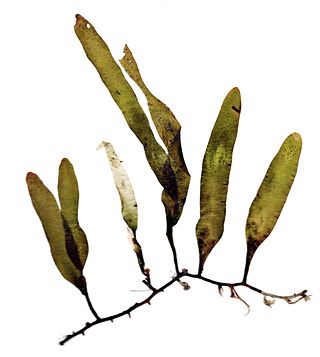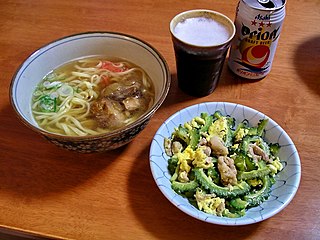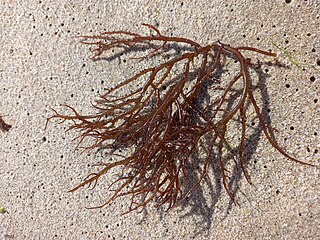Sea grape or seagrape may refer to:

The sea lettuces comprise the genus Ulva, a group of edible green algae that is widely distributed along the coasts of the world's oceans. The type species within the genus Ulva is Ulva lactuca, lactuca being Latin for "lettuce". The genus also includes the species previously classified under the genus Enteromorpha, the former members of which are known under the common name green nori.

Caulerpa taxifolia is a species of green seaweed, an alga of the genus Caulerpa, native to tropical waters of the Pacific Ocean, Indian Ocean, and Caribbean Sea. The species name taxifolia arises from the resemblance of its leaf-like fronds to those of the yew (Taxus).

Caulerpa is a genus of seaweeds in the family Caulerpaceae. They are unusual because they consist of only one cell with many nuclei, making them among the biggest single cells in the world.

Caulerpa racemosa is a species of edible green alga, a seaweed in the family Caulerpaceae. It is commonly known as sea grapes and is found in many areas of shallow sea around the world. Despite the name, it is not related to grapes. There are a number of different forms and varieties, and one that appeared in the Mediterranean Sea in 1990, which is giving cause for concern as an invasive species.

Gracilaria, also known as irish moss or ogonori, is a genus of red algae in the family Gracilariaceae. It is notable for its economic importance as an agarophyte meaning that it is used to make agar, as well as its use as a food for humans and various species of shellfish. Various species in the genus are cultivated among Asia, South America, Africa and Oceania. They produce over 90% of the world's agar.

Porphyra is a genus of coldwater seaweeds that grow in cold, shallow seawater. More specifically, it belongs to red algae phylum of laver species, comprising approximately 70 species. It grows in the intertidal zone, typically between the upper intertidal zone and the splash zone in cold waters of temperate oceans. In East Asia, it is used to produce the sea vegetable products nori and gim. There are considered to be 60–70 species of Porphyra worldwide and seven around Britain and Ireland, where it has been traditionally used to produce edible sea vegetables on the Irish Sea coast. The species Porphyra purpurea has one of the largest plastid genomes known, with 251 genes.

Okinawan cuisine is the cuisine of the Okinawa Prefecture of Japan. The cuisine is also known as Ryūkyūan cuisine, a reference to the Ryukyu Kingdom. Due to differences in culture, historical contact between other regions, climate, vegetables and other ingredients, Okinawan cuisine differs from mainland Japanese cuisine.

Kinilaw is a raw seafood dish and preparation method native to the Philippines. It is sometimes also referred to as Philippine ceviche due to its similarity to the Latin American dish ceviche. It is more accurately a cooking process that relies on vinegar and acidic fruit juices to denature the ingredients, rather than a dish, as it can also be used to prepare meat and vegetables. Kinilaw dishes are usually eaten as appetizers before a meal, or as finger food with alcoholic drinks. Kinilaw is also sometimes called kilawin, especially in the northern Philippines, but the term kilawin more commonly applies to a similar lightly grilled meat dish.

Limu, otherwise known as rimu, remu or ʻimu is a general Polynesian term for edible plants living underwater, such as seaweed, or plants living near water, like algae. In Hawaii, there are approximately one hundred names for kinds of limu, sixty of which can be matched with scientific names. Hundreds of species of marine algae were once found in Hawaii. Many limu are edible, and used in the cuisine throughout most of Polynesia.

Seaweed, or macroalgae, refers to thousands of species of macroscopic, multicellular, marine algae. The term includes some types of Rhodophyta (red), Phaeophyta (brown) and Chlorophyta (green) macroalgae. Seaweed species such as kelps provide essential nursery habitat for fisheries and other marine species and thus protect food sources; other species, such as planktonic algae, play a vital role in capturing carbon and producing at least 50% of Earth's oxygen.

Edible seaweed, or sea vegetables, are seaweeds that can be eaten and used for culinary purposes. They typically contain high amounts of fiber. They may belong to one of several groups of multicellular algae: the red algae, green algae, and brown algae. Seaweeds are also harvested or cultivated for the extraction of polysaccharides such as alginate, agar and carrageenan, gelatinous substances collectively known as hydrocolloids or phycocolloids. Hydrocolloids have attained commercial significance, especially in food production as food additives. The food industry exploits the gelling, water-retention, emulsifying and other physical properties of these hydrocolloids.

Seaweed farming or kelp farming is the practice of cultivating and harvesting seaweed. In its simplest form farmers gather from natural beds, while at the other extreme farmers fully control the crop's life cycle.

Caulerpa prolifera is a species of green alga, a seaweed in the family Caulerpaceae. It is the type species of the genus Caulerpa, the type location being Alexandria, Egypt. It grows rapidly and forms a dense mass of vegetation on shallow sandy areas of the sea.

Eucheuma, commonly known as sea moss or gusô, is a rhodophyte seaweed that may vary in color. Eucheuma species are used in the production of carrageenan, an ingredient for cosmetics, food processing, and industrial manufacturing, as well as a food source for people in the Philippines, Caribbean and parts of Indonesia and Malaysia. Eucheuma cottonii – which grows in the Caribbean and cultivated in the Philippines – is the particular species known as gusô. Other species include Betaphycus gelatinae, Eucheuma denticulatum, and several species of the genus Kappaphycus, including K. alvarezii. Since the mid-1970s, Kappaphycus and Eucheuma have been a major source for the expansion of the carrageenan industry.

Caulerpa sedoides, also known as mini-grapes or bubble caulerpa, is a species of seaweed in the Caulerpaceae family native to Australia.

Sacoproteus is a genus of sea slugs in the Limapontiidae family, described in 2018. It contains five species, of which four were newly described when the genus was erected, and one was reassigned from its previous classification of Stiliger smaragdinus as the type species of the new genus. Most of the species are mimetic of toxic "sea-grape" algae in the genus Caulerpa.

Gracilaria coronopifolia, also known as limu manauea in Hawaiian, or ogo in Japanese, is a species of edible red algae (Rhodophyta) endemic to Hawai'i.























